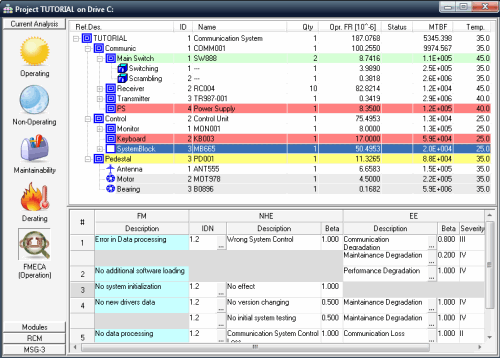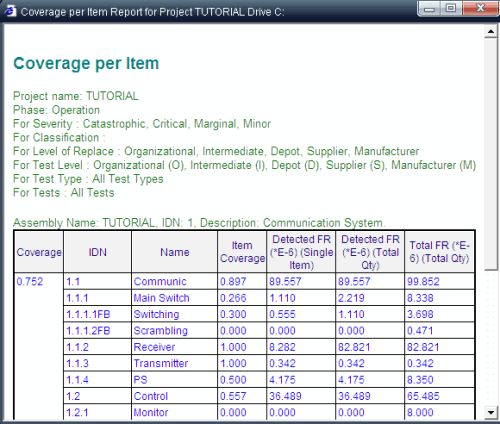FMECA / Testability Analysis
Libraries
Module Features
Standard Reports
Testability Analysis
Failure Mode, Effects and Criticality Analysis (FMECA) is a natural continuation, and in many cases inseparable part of the Reliability Analysis. Previously a separate software package, FMECA is now a fully-integrated RAM Commander module. FMECA software tool uses a product tree previously created by the RAM Commander user for the reliability analysis purposes.
The RAM Commander FMECA module is suitable for both hardware and functional approaches to FMECA, and fully complies with MIL-STD-1629 A, commercial standards, and Good Manufacturing Practice (GMP) requirements, and supports the functional safety analysis according to IEC 61508. RAM Commander FMECA software module makes the FMEA process easy and visible: the product tree and the corresponding to each item sequence of Failure Modes => Next Higher Effects => End Effects are totally visible in the same window.
Extensive use of the FMECA Libraries facilitates the process even more and contributes to the accuracy of the performed analyses and reports. You can perform both the FMEA and FMECA calculating failure mode ratios, conditional probabilities and item criticality numbers.
Extensive use of the FMECA Libraries facilitates the process even more and contributes to the accuracy of the performed analyses and reports. You can perform both the FMEA and FMECA calculating failure mode ratios, conditional probabilities and item criticality numbers.
FMECA Libraries
• Typical Failure Modes – based on FMD-97, FMD-2013, CENELEC EN 50129, AREMA, NSWC-11, IEC-62380
• Typical Failure Modes – custom
• Standard Failure Modes
• End Effects & Severities
• Failure Mode Full Description
• Test methods and types
• Severities, Criticality groups, Failure classes
• Typical Failure Modes – custom
• Standard Failure Modes
• End Effects & Severities
• Failure Mode Full Description
• Test methods and types
• Severities, Criticality groups, Failure classes
FMECA Module Features
• Multiple phases, different EE severity in different phases
• Full FM-NHE-EE chain input with unlimited number of NHE (Next Higher Effect)
• Functional Blocks, analysis on components or on functional level
• Customizable additional fields, customizable field names
• More than 50 reports: FMEA, Criticality Matrix, Criticality Analysis and more
• Graphical Fault Isolation Tree
• Fault Tree Report, automatical fault tree creation in FTA Software Module
• Import/Export to and from Excel
• Report Generator
• Full FM-NHE-EE chain input with unlimited number of NHE (Next Higher Effect)
• Functional Blocks, analysis on components or on functional level
• Customizable additional fields, customizable field names
• More than 50 reports: FMEA, Criticality Matrix, Criticality Analysis and more
• Graphical Fault Isolation Tree
• Fault Tree Report, automatical fault tree creation in FTA Software Module
• Import/Export to and from Excel
• Report Generator
FMECA Standard Reports
• FMEA – MIL-STD-1629
• FMEA – GJB 1391-92
• FMECA
• FMEDA (Failure Mode, Effects and Diagnostics Analysis)
• LSA FMEA
• Criticality Analysis – MIL-STD-1629
• Criticality Analysis – GJB 1391-92
• End Effects Criticality Numbers
• Criticality Matrix
• Fault Tree
• NHE Critcality
• Test methods
• BIT/Detection Coverage
• Detectable/Undetectable Failures
• Fault Isolation Resolution
• FMEA – GJB 1391-92
• FMECA
• FMEDA (Failure Mode, Effects and Diagnostics Analysis)
• LSA FMEA
• Criticality Analysis – MIL-STD-1629
• Criticality Analysis – GJB 1391-92
• End Effects Criticality Numbers
• Criticality Matrix
• Fault Tree
• NHE Critcality
• Test methods
• BIT/Detection Coverage
• Detectable/Undetectable Failures
• Fault Isolation Resolution
Testability Analysis
Testability Analysis sub-module of the FMECA module is intended for in-depth Testability analysis. The main characteristics of Testability – BIT/Detection Coverage and Fault Isolation Resolution – can be calculated for each maintenance level (Organizational, Intermediate, Depot) and for specific detection methods (BIT, BITE, external test equipment, etc.). Test method efficiency and indication are defined for each test method or a group of test methods.Testability analysis is widely used for the development of necessary supporting documentation: maintenance manuals, troubleshooting procedures and inspection requirements.
Download the latest version of RAM Commander


